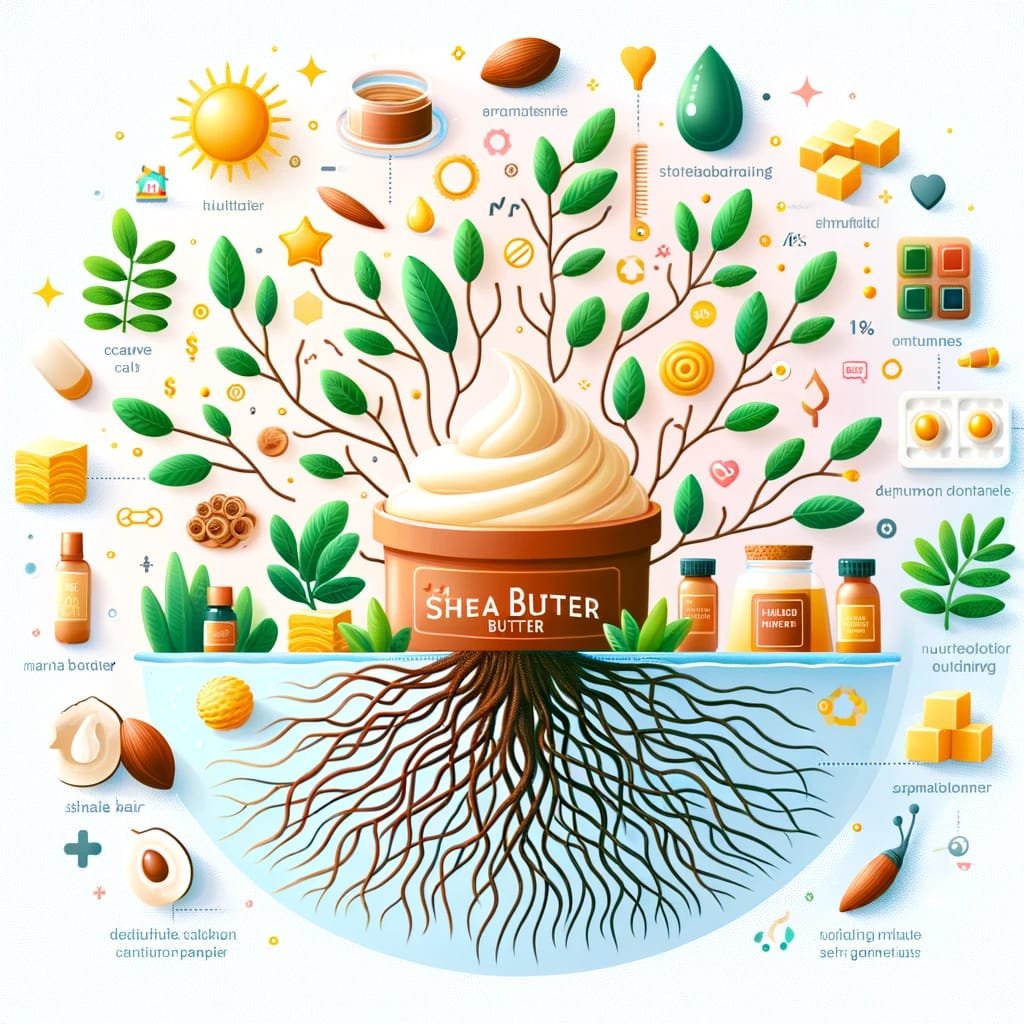Brief Overview of Shea Butter and Its Origins
Shea butter, a remarkable natural ingredient with an extensive history, originates from the nuts of the shea tree (Vitellaria paradoxa), also known as the karite tree. This majestic tree is indigenous to various regions of Africa, particularly the sub-Saharan areas.
The extraction process involves collecting ripe shea nuts and carefully roasting them before crushing and grinding them into a paste. This paste is then boiled to separate the fats, which are skimmed off the surface and allowed to solidify into what we know as shea butter.
For centuries, shea butter has been treasured by African communities for its impressive skin and hair benefits. It has played a vital role in both beauty rituals and traditional medicinal practices.
Women in Africa have passed down their knowledge of shea butter’s properties from generation to generation, appreciating it as a versatile remedy for various skincare concerns such as dryness, eczema, and inflammation. This exceptional substance has gained global recognition due to its rich composition.
Shea butter is naturally packed with essential fatty acids like oleic acid (omega-9) and stearic acid, which contribute to its moisturizing qualities. It also contains an array of vitamins including vitamins A and E—powerful antioxidants that offer numerous benefits for both scalp health and hair growth.

Introduction to the Topic of Using Shea Butter for Hair Growth
The quest for long, lustrous locks has captivated humans since ancient times. Throughout history, people have explored countless remedies in pursuit of healthy hair growth.
One such remedy that has gained popularity in recent years is using shea butter as a natural aid for promoting stronger strands and encouraging hair growth. While there isn’t a magical solution capable of overnight transformations or defying the natural hair growth cycle, shea butter has emerged as a promising option due to its unique properties.
By deeply moisturizing the hair shaft and nourishing the scalp, shea butter can address underlying factors that may hinder optimal hair growth. Additionally, it offers protection against environmental stressors that can lead to breakage and damage.
As interest in natural beauty and holistic approaches continues to expand, shea butter’s potential contribution to hair growth cannot be overlooked. With its rich history in traditional African practices and increasing scientific exploration, understanding how shea butter works on a molecular level may unlock its secrets for enhancing hair health.
Understanding Shea Butter
Shea butter, derived from the nuts of the shea tree (Vitellaria paradoxa), is a versatile natural ingredient that has gained widespread recognition for its numerous skincare and haircare benefits. To fully understand its potential in promoting hair growth, it is essential to delve into the definition and extraction process of shea butter.
The extraction of shea butter involves a meticulous traditional method that has been passed down through generations in African cultures. Mature shea tree nuts are collected and cracked open to reveal the kernels inside.
These kernels are then roasted, ground, and kneaded to separate the oily components from the remaining solids. The resulting paste undergoes a slow boiling process, allowing impurities to rise to the surface and be skimmed off.
After cooling and solidifying, the pure shea butter is obtained. Composition: Shea butter’s unique composition plays a pivotal role in its ability to support hair growth.
It contains an array of vitamins, fatty acids, and other beneficial compounds that contribute to its nourishing properties. For instance, vitamins A and E are prominent in shea butter.
Vitamin A promotes sebum production on the scalp which provides moisture for healthy hair follicles, while vitamin E acts as a potent antioxidant that protects against free radicals known to damage hair cells. Aside from vitamins, fatty acids such as oleic acid (omega-9) and stearic acid also constitute a significant portion of shea butter’s composition.
These fatty acids have emollient properties that help seal moisture into the hair shafts by forming a protective barrier on the cuticles. This not only prevents dehydration but also reduces breakage caused by external factors like heat styling or environmental stressors.
Historical Use in African Cultures
The historical use of shea butter in African cultures for skincare and haircare purposes dates back centuries. Indigenous communities recognized its exceptional qualities and incorporated shea butter into their daily grooming rituals. It became an integral part of their beauty regimens, particularly for promoting healthy skin and lustrous hair.
Throughout Africa, shea butter has been traditionally used as a natural remedy to address various hair concerns. Its deep moisturizing properties make it highly effective in combating dryness, which is a common cause of brittle hair and breakage.
By providing ample hydration to the strands, shea butter helps maintain the elasticity and strength needed for optimal hair growth. In addition to moisturization, shea butter has also been valued for its ability to soothe irritated scalps.
African cultures have utilized its anti-inflammatory properties to alleviate conditions like dandruff or eczema that can hinder healthy hair growth. By reducing scalp inflammation, shea butter promotes a more conducive environment for robust follicle function, thereby supporting the growth of strong, resilient hair.
III. The Science Behind Hair Growth
Explanation of the Hair Growth Cycle
T understand how shea butter may contribute to hair growth, it is crucial to grasp the intricate process of the hair growth cycle. The hair growth cycle consists of three main phases: anagen, catagen, and telogen.
Firstly, during the anagen phase, which is often referred to as the active growth phase, hair follicles are actively producing new cells and resulting in visible hair growth. This phase can last for several years and varies depending on factors such as genetics and individual characteristics.
Following the anagen phase comes the catagen phase, known as the transitional period. During this stage, cell production slows down significantly, leading to a cessation of hair growth.
This transitional phase lasts for only a few weeks before entering into telogen phase—the resting or shedding period. In this final stage of the hair growth cycle, old hairs are released and new ones start growing in their place.
Factors Influencing Hair Growth Rate
Various factors influence the rate at which our hair grows. Genetics p a fundamental role; individuals inherit certain genetic traits that determine their predisposition for fast or slow hair growth. Age also impacts hair growth rate since it tends to slow down over time due to hormonal changes and decreasing cell division rates.
Moreover, hormonal changes can significantly affect hair growth patterns in both men and women. Hormones such as estrogen and testosterone play pivotal roles in regulating follicle development and determining whether hairs grow thick or thin.
Overall health also plays a crucial role in determining how efficiently our bodies produce new cells for healthy hair growth. Nutritional deficiencies or underlying health conditions can impede proper cell division required for robust follicle activity.
Role of Scalp Health in Promoting Optimal Hair Growth
Scalp health is vital for promoting optimal hair growth. A healthy scalp serves as the foundation for nourishing and supporting hair follicles.
Any issues that disrupt the scalp’s balance, such as dryness, inflammation, or excess oil production, can hinder hair growth. When the scalp is dry and lacks moisture, it can lead to brittle and weak hair prone to breakage.
On the other hand, an excessively oily scalp may clog follicles and impede healthy hair growth. Maintaining a clean and well-nourished scalp is crucial.
Regularly cleansing the scalp, using gentle products that do not strip away natural oils, helps ensure a conducive environment for robust hair growth. Additionally, maintaining proper hydration through adequate water intake promotes overall scalp health.
Understanding the science behind hair growth allows us to comprehend how shea butter might contribute to promoting healthier strands. The complex process of the hair growth cycle relies on factors like genetics, age, hormonal changes, and overall health.
Moreover, maintaining an optimal scalp condition through proper hydration and care is pivotal for encouraging robust hair follicle activity. By exploring these aspects in detail, we can further investigate how shea butter’s properties align with promoting favorable conditions for healthy hair growth potential.
Moisturizing Properties of Shea Butter
Shea butter is renowned for its exceptional moisturizing properties, making it an excellent ally in the quest for luscious locks. One of the key reasons why shea butter is effective in promoting hair growth is its ability to combat dryness and prevent breakage.
The rich composition of fatty acids present in shea butter allows it to deeply penetrate the hair shaft, providing much-needed nourishment and hydration to the strands. By replenishing lost moisture, shea butter helps to restore the health and vitality of brittle hair, reducing the risk of damage and promoting stronger hair growth.
Furthermore, shea butter forms a protective barrier on the scalp that helps retain moisture and shields against external aggressors. This barrier acts as a shield against excessive moisture loss due to environmental factors like sun exposure or cold winds.
By locking in moisture, shea butter prevents dryness and keeps your scalp hydrated, creating an optimal environment for healthy hair growth. Its emollient properties also help to smooth down cuticles and reduce frizz, resulting in shinier, more manageable hair.
Anti-Inflammatory Effects
In addition to its moisturizing prowess, shea butter possesses remarkable anti-inflammatory effects that can soothe various scalp conditions like dandruff or eczema. Scalp inflammation can hinder proper hair growth by disrupting follicular activity.
However, when applied topically, shea butter’s anti-inflammatory compounds work harmoniously to calm irritated skin and promote a healthier scalp environment for better follicular function. Moreover, shea butter provides relief from itchiness or discomfort often associated with common scalp issues.
This alleviation not only enhances comfort but also prevents scratching-induced damage that could weaken or break hair strands. By soothing irritated areas and reducing inflammation at the root level, shea butter contributes significantly to establishing favorable conditions for optimal hair growth.
Presence of Essential Vitamins (A, E)
Shea butter is not only a natural moisturizer and anti-inflammatory agent but also contains essential vitamins that support healthy hair follicles. Vitamin A, present in significant amounts within shea butter, promotes sebum production. Sebum acts as a natural conditioner, keeping the scalp adequately moisturized and nourished.
This enhanced sebum production helps to restore balance to dry or overactive oil glands, subsequently improving the overall health of the scalp and hair. Furthermore, shea butter incorporates considerable amounts of vitamin E, a potent antioxidant renowned for its rejuvenating properties.
Vitamin E protects against oxidative stress caused by free radicals that can damage cells and impede hair growth. Its antioxidant power facilitates the repair of damaged follicles and promotes the growth of healthy new strands.
Conclusion
Shea butter presents a remarkable array of benefits for promoting hair growth and maintaining overall hair health. Its moisturizing properties combat dryness and prevent breakage by deeply nourishing the strands while forming a protective barrier on the scalp to retain moisture and prevent environmental damage.
The anti-inflammatory effects of shea butter soothe irritated scalp conditions like dandruff or eczema while reducing inflammation for healthier follicles and better hair growth. Additionally, its abundance in essential vitamins A and E supports optimal scalp health by promoting sebum production for moisturization and acting as a potent antioxidant against oxidative stress.
By incorporating shea butter into your hair care routine, you can enjoy not only stronger and more resilient locks but also an improved overall aesthetic appeal. Embrace the wonders of nature’s treasure- shea butter- to unlock your hair’s true potential with its transformative qualities.





